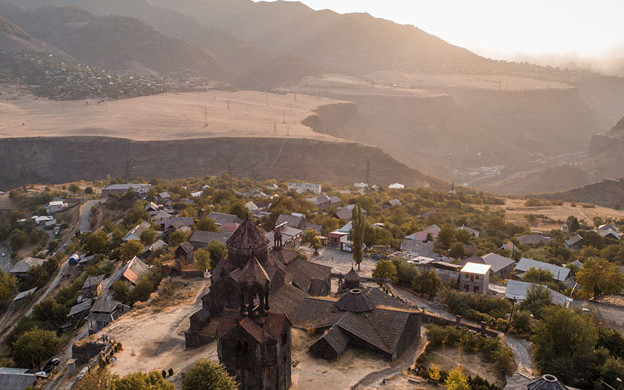L'Arménie, un pays aux mille trésors cachés
Découvrez l'Arménie, un joyau culturel et naturel unique.
Laissez-vous envoûter par l'histoire et la beauté de l'Arménie.
Arménie : entre paysages époustouflants et traditions millénaires
Longtemps terre de pèlerinage des Arméniens de la diaspora, le pays s'ouvre depuis plusieurs années à tous les visiteurs. Ses principaux atouts sont ses hautes montagnes, ses lacs et ses vallées, écrins d'innombrables églises et monastères rappelant que l'Arménie fut le premier État chrétien. Terre de mémoire, l'Arménie est cependant aussi une terre d'aventure prisée pour la pratique de la randonnée. Pour en saisir les multiples facettes, rien de tel qu'un voyage organisé par une agence locale ! En effet, les Arméniens sont sans doute les mieux placés pour faire découvrir de façon authentique ce pays qui fait encore ses débuts dans le tourisme.
Un trésor caché à explorer
Faire un voyage en Arménie, c'est partir à la découverte d'un pays méconnu, loin du tourisme de masse. Née sur les ruines de l'Empire russe, l'Arménie actuelle n'occupe que la partie orientale de l'Arménie historique et réunit à peine la moitié des Arméniens du globe. Ce pays, riche en histoire et en culture, offre des paysages variés allant des montagnes majestueuses aux vallées verdoyantes. Les visiteurs peuvent explorer des monastères anciens, déguster une cuisine locale savoureuse et rencontrer des habitants chaleureux et accueillants. L'Arménie est une destination idéale pour ceux qui cherchent à vivre une expérience authentique et enrichissante.

Les incontournables à visiter
Visiter l'Arménie, c'est d'abord découvrir sa belle capitale, Erevan. Son centre historique est riche en beaux bâtiments du XIXe siècle, en petites places charmantes et en musées, tandis que sa périphérie est marquée par des édifices soviétiques. La vie culturelle d'Erevan est dense, avec de nombreux concerts, des salles de théâtre, des galeries d'art. Mais ce qui rend la capitale arménienne si attachante, c'est surtout l'accueil chaleureux et la gentillesse de ses habitants.
Situé à 1 900 mètres d'altitude et d'une superficie totale de 940 km², le lac Sevan est une halte rafraîchissante en été, tandis qu'il règne une chaleur caniculaire à Erevan. Ce qui le rend presque aussi célèbre que le Mont Ararat ! D'un bleu profond, c'est aussi un des lacs d'Arménie les plus riches en poissons, parfait pour les amateurs de pêche.
À environ 10 km de Garni et son superbe temple gréco-romain, non loin d'Erevan, au milieu d'un canyon, se trouve le monastère de Geghard. Ce monastère, qui doit son nom à la lance qui traversa le corps du Christ, a été construit au XIIIe siècle. Il a pour particularité d'être en grande partie souterrain. C'est un incontournable lors de tout voyage en Arménie.

Découvrez l'Arménie authentique : trésors cachés et paysages uniques
Traversez le pont suspendu aux grottes de Goris
Près du village de Goris, se trouve un impressionnant pont suspendu au-dessus du vide dans une gorge des montagnes du Caucase. Le traverser est toujours une expérience riche en sensations fortes. Cependant, il est conseillé aux personnes sujettes au vertige de s'abstenir.
Empruntez le téléphérique de Tatev
Non loin de Goris se trouve un monastère perché sur une falaise de 850 mètres. Pour s'y rendre, il est possible de prendre un téléphérique depuis le village d'Halidzor. C'est une expérience mémorable car ce téléphérique est l'un des plus longs du monde.
La magnifique cascade de Jermuk
Perchée à plus de 2 000 mètres d'altitude, Jermuk est une ville thermale des hautes montagnes d'Arménie. Elle est célèbre pour ses sources bienfaisantes mais aussi pour sa magnifique cascade, haute de 70 mètres, qui se jette dans la rivière Arpa.
Découverte de l'Arménie
L'Arménie n'est pas une destination touristique convenue, ce qui présente des avantages pour les amateurs de voyages hors des sentiers battus. Ce caractère atypique se traduit par des infrastructures touristiques particulières, typiques de nombreux pays de l'ex-URSS. Cependant, on y gagne en authenticité et parfois en exotisme et en pittoresque. Le dépaysement est d'autant plus assuré que l'Arménie est un pays du choc des cultures, où l'Orient et l'Occident se rencontrent. La chrétienté arménienne, avec sa liturgie héritée de Byzance et ses rites influencés par le paganisme, est résolument orientale. Mais le contraste est saisissant entre un monastère à la silhouette romane niché dans un paysage de prairie et le haut plateau brûlé par le soleil qui rappelle les steppes d'Asie centrale. À Erevan, l'attrait de l'Occident est visible chez une jeunesse sensible aux modes musicales et vestimentaires venues de l'Ouest. Toutefois, la nonchalance orientale d'une population sur les terrasses de café rappelle la proximité de l'Iran.
A website by
Customize your trips with Quotatrip and receive tailor-made offers directly in your inbox.
Discover a country
Copyright 2025 © Quotatrip.